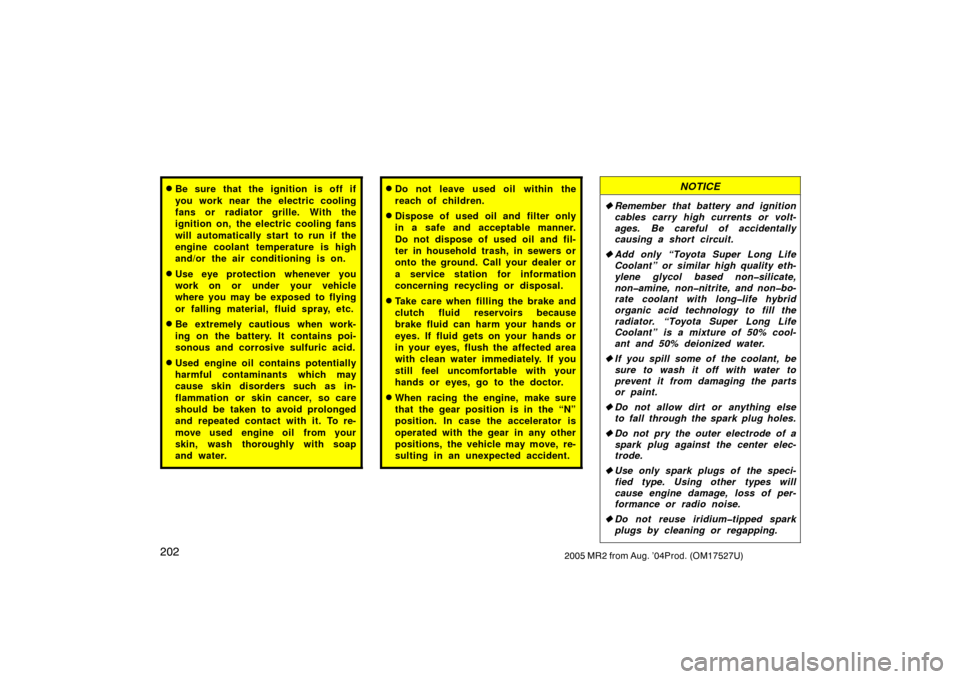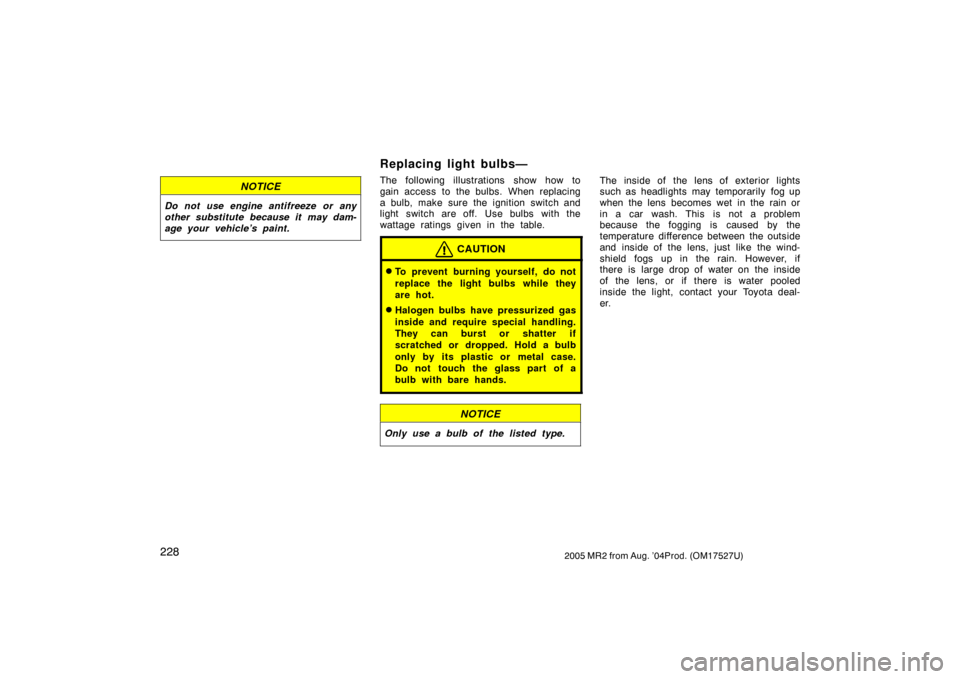Page 210 of 259

2022005 MR2 from Aug. ’04Prod. (OM17527U)
�Be sure that the ignition is off if
you work near the electric cooling
fans or radiator grille. With the
ignition on, the electric cooling fans
will automatically start to run if the
engine coolant temperature is high
and/or the air conditioning is on.
�Use eye protection whenever you
work on or under your vehicle
where you may be exposed to flying
or falling material, fluid spray, etc.
�Be extremely cautious when work-
ing on the battery. It contains poi-
sonous and corrosive sulfuric acid.
�Used engine oil contains potentially
harmful contaminants which may
cause skin disorders such as in-
flammation or skin cancer, so care
should be taken to avoid prolonged
and repeated contact with it. To re-
move used engine oil from your
skin, wash thoroughly with soap
and water.
�Do not leave used oil within the
reach of children.
�Dispose of used oil and filter only
in a safe and acceptable manner.
Do not dispose of used oil and fil-
ter in household trash, in sewers or
onto the ground. Call your dealer or
a service station for information
concerning recycling or disposal.
�Take care when filling the brake and
clutch fluid reservoirs because
brake fluid can harm your hands or
eyes. If fluid gets on your hands or
in your eyes, flush the affected area
with clean water immediately. If you
still feel uncomfortable with your
hands or eyes, go to the doctor.
�When racing the engine, make sure
that the gear position is in the “N”
position. In case the accelerator is
operated with the gear in any other
positions, the vehicle may move, re-
sulting in an unexpected accident.
NOTICE
�Remember that battery and ignition
cables carry high currents or volt-
ages. Be careful of accidentally
causing a short circuit.
�Add only “Toyota Super Long Life
Coolant” or similar high quality eth-
ylene glycol based non�silicate,
non�amine, non�nitrite, and non�bo-
rate coolant with long�life hybrid
organic acid technology to fill the
radiator. “Toyota Super Long Life
Coolant” is a mixture of 50% cool-
ant and 50% deionized water.
�If you spill some of the coolant, be
sure to wash it off with water to
prevent it from damaging the parts
or paint.
�Do not allow dirt or anything else
to fall through the spark plug holes.
�Do not pry the outer electrode of a
spark plug against the center elec-
trode.
�Use only spark plugs of the speci-
fied type. Using other types will
cause engine damage, loss of per-
formance or radio noise.
�Do not reuse iridium�tipped spark
plugs by cleaning or regapping.
Page 233 of 259
2262005 MR2 from Aug. ’04Prod. (OM17527U)
Checking and replacing fuses
SB73035
Good Blown
Ty p e A
SB73036
GoodBlown
Ty p e B
SB73037
Good Blown
Ty p e C
SB73066
If the headlights or other electrical
components do not work, check the
fuses. If any of the fuses are blown,
they must be replaced.
See “Fuse locations” on page 200 in Sec-
tion 7−1 for locations of the fuses.
Turn the ignition switch and inoperative
component off. Pull the suspected fuse
straight out and check it.
Determine which fuse may be causing the
problem. The lid of the fuse box shows
the name of the circuit for each fuse. See
page 245 in Section 8 for the functions
controlled by each circuit.
Type A fuses can be pulled out by the
pull−out tool. The location of the pull−out
tool is shown in the illustration.
Page 235 of 259

2282005 MR2 from Aug. ’04Prod. (OM17527U)
NOTICE
Do not use engine antifreeze or any
other substitute because it may dam-
age your vehicle’s paint.
Replacing light bulbs—
The following illustrations show how to
gain access to the bulbs. When replacing
a bulb, make sure the ignition switch and
light switch are off. Use bulbs with the
wattage ratings given in the table.
CAUTION
�To prevent burning yourself, do not
replace the light bulbs while they
are hot.
�Halogen bulbs have pressurized gas
inside and require special handling.
They can burst or shatter if
scratched or dropped. Hold a bulb
only by its plastic or metal case.
Do not touch the glass part of a
bulb with bare hands.
NOTICE
Only use a bulb of the listed type.
The inside of the lens of exterior lights
such as headlights may temporarily fog up
when the lens becomes wet in the rain or
in a car wash. This is not a problem
because the fogging is caused by the
temperature difference between the outside
and inside of the lens, just like the wind-
shield fogs up in the rain. However, if
there is large drop of water on the inside
of the lens, or if there is water pooled
inside the light, contact your Toyota deal-
er.
Page 253 of 259

2462005 MR2 from Aug. ’04Prod. (OM17527U)
SB73068a
Engine compartment
24. TAIL1 20 A: “TAIL2” “PANEL” fuses
25. D P/W 20 A: Power window system
26. P P/W 20 A: Power window system
27. RADIO1 15 A: Power antenna, audio
28. DOME 10 A: Clock
29. ECU�B 10 A: Daytime running light
system, gauges and meters
30. TAIL2 10 A: Taillights, parking lights,
license plate lights, gauges and meters
31. PANEL 7.5 A: Clock, illuminations
32. RADIO2 7.5 A: Gauges and meters,
outside rear view mirror system, clock33. CIG 15 A: Cigarette lighter
34. I/UP 7.5 A: Engine idle up system
35. ALT�S 7.5 A: Charging system
36. ECU�B1 25 A: “ECU−B” “DOME” fuses
37. SMT�B 10A: Sequential manual trans-
mission system
38. HORN 10 A: Horn
39. HAZ 15 A: Turn signal lights, emergen-
cy flashers
40. AM2 15 A: Starter system, multiport
fuel injection system/sequential multi-
port fuel injection system, SRS airbag
system
41. IG2 15 A: Ignition system, multiport
fuel injection system/sequential multi-
port fuel injection system
42. EFI1 15 A: Multiport fuel injection sys-
tem/sequential multiport fuel injection
system, engine immobilizer system
43. ETCS 15A: Multiport fuel injection sys-
tem/sequential multiport fuel injection
system
44. HPU 30A: Sequential manual transmis-
sion system
45. HEAD RH LWR 10A: Right−hand head-
light (low beam)46. HEAD LH LWR 10A: Left−hand head-
light (low beam)
47. EFI2 7.5 A: Multiport fuel injection sys-
tem/sequential multiport fuel injection
system
48. ST 7.5 A: Starter system
49. SMT�IG 10A: Sequential manual trans-
mission system
50. DRL NO.1 7.5 A: Daytime running light
system
Fuses (type B)
51. ABS2 50 A: Anti−lock brake system
52. EHPS 50 A: Power steering system
53. MAIN 40 A: Starter system, “DRL
NO.1” “HEAD LH LWR” “HEAD RH
LW R ” f u s e s
54. HTR 40 A: Air conditioning system
Fuses (type C)
55. ALT 100 A: “AM1” “D P/W” “P P/W”
“DOOR” “STOP” “EHPS” “DEF” “TAIL1”
“OBD” “HTR 40A” fuses